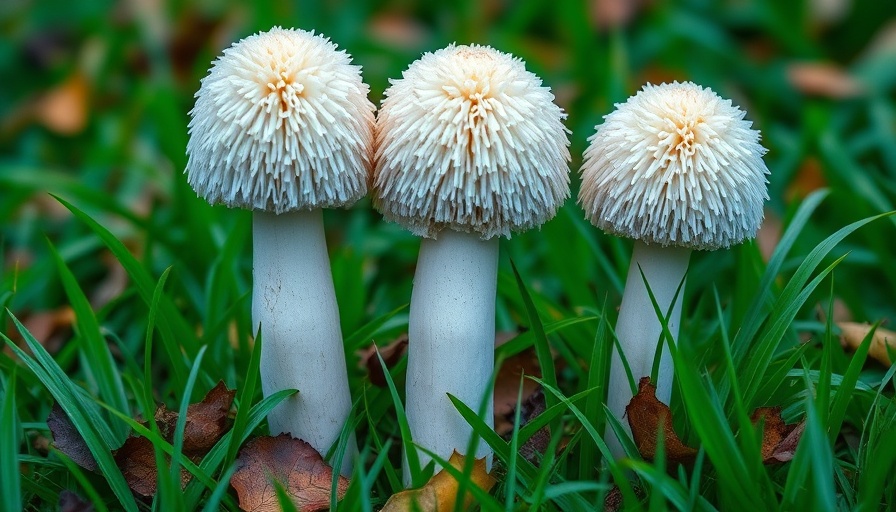
What Mushrooms Are Growing In Your Grass and What It Means for Your Lawn
If you've noticed mushrooms sprouting in your luscious green grass, you're not alone. For many California homeowners, the appearance of mushrooms can elicit a mix of concern and curiosity. However, these fungi often serve as signals of the health of your soil rather than mere nuisances. In fact, many mushrooms thrive in healthy environments, and understanding what they indicate can help you maintain a vibrant lawn.
Understanding the Role of Mushrooms in Your Lawn
Mushrooms are part of the fungal kingdom and have a significant role in the ecosystem of your lawn. Experts such as Claudia Bashian-Victoroff, a fungal ecologist at Holden Arboretum, explain that these organisms could be beneficial indicators of the soil's health. “Fungi like those you see in your lawn often indicate rich microbial activity beneath the surface,” she notes. Upon spotting mushrooms, resist the urge to panic; they often mean your lawn is thriving.
Top Mushrooms to Spot in California Lawns
While California's diverse climates allow for many unique mushroom species to thrive, here are some of the most common varieties you might encounter:
- Button Mushroom (Agaricus bisporus): A culinary favorite known for its grayish-white cap. Ideal for raindrenched lawns, it indicates a healthy soil structure.
- Parasol Mushroom (Macrolepiota procera): Recognizable by its large cap and edible nature, but be cautious; it can resemble poisonous counterparts.
- Ringless Honey Mushrooms (Armillaria tabascens): Often found near tree bases, these clusters are indicators of decaying organic material.
- Shaggy Ink Cap (Coprinus comatus): These mushrooms transform from a bulbous cap into a black ink substance within a day, leaving behind spores that promote soil health.
The Importance of Soil Health
With an emphasis on maintaining lush environments, knowing what type of mushrooms are sprouting can serve a practical purpose. Healthy soils are defined by its environmental conditions, which include moisture, pH levels, and organic matter. As Bashian-Victoroff highlights, it’s crucial to look at mushrooms as indirect indicators of moisture and health in your grass.
Practical Insights: Managing Unwanted Fungi
Not all mushrooms should be celebrated. If fungi become persistent and unwanted, it's time to take action. Reducing soil moisture can prevent the growth of certain species. Strategies include:
- Aerating the Soil: This creates better drainage and reduces excessive moisture.
- Landscaping Changes: Adding landscaping features like trees can absorb excess moisture.
- Proper Composting: Instead of leaving dead plant matter on your lawn, opt to compost it to reduce fungal growth.
Safety and Awareness: Handling Mushrooms
While mushrooms growing in your lawn might feel concerning, there is generally no need for alarm. Bashian-Victoroff emphasizes that handling mushrooms poses no physical threat unless ingested. For safety, consult with a local expert about identification if you are uncertain. Always keep pets and young children away if excited about their discovery.
Future Insights: The Evolving Landscape of Urban Fungi
Looking ahead, urban sprawl and changing climates will continue to impact the fungal species found within California lawns. More diverse ecosystems could lead to new mushrooms appearing, and understanding this relationship can help homeowners foster a more biodiverse, resilient garden.
Common Misconceptions and Myths
One prevalent misconception is that all mushrooms are harmful. In reality, the presence of certain mushrooms can indicate a thriving ecosystem. Depending on the species, they can either contribute positively to your lawn or should be managed cautiously. Education is key to dispelling myths surrounding these complex organisms.
In conclusion, embracing the natural beauty of your lawn, including its mushroom inhabitants, allows you to engage more fully with your outdoor space. Your lawn is a reflection of your home's overall health, underscoring the importance of soil and moisture management. This spring, take the opportunity to learn more about mushrooms and what they signify for your gardening practices.
So next time you spot a mushroom, remember to celebrate the often-unseen life thriving in your yard. For further assistance in managing your lawn and understanding fungi better, consider reaching out to local landscaping services or mycologists for guidance.
 Add Row
Add Row  Add
Add 




Write A Comment